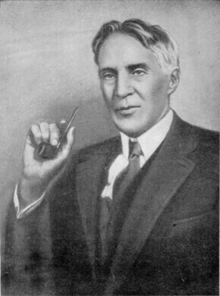Robert W. Wood
| Robert W. Wood | |
|---|---|
 |
|
| Born | Robert Williams Wood May 2, 1868 Concord, Massachusetts, United States |
| Died | August 11, 1955 (aged 87) Amityville, New York, United States |
| Nationality | American |
| Fields | Physics |
| Education | Roxbury Latin School |
| Alma mater |
Harvard University Massachusetts Institute of Technology University of Chicago |
| Known for | |
| Notable awards |
|
Robert Williams Wood (May 2, 1868 – August 11, 1955) was an American physicist and inventor. He is often cited as being a pivotal contributor to the field of optics and a pioneer of infrared and ultraviolet photography. Wood's patents and theoretical work shed much light on the nature and physics of ultra-violet radiation, and made possible the myriad uses of UV-fluorescence which became popular after World War I.
Born in Concord, Massachusetts, Wood attended The Roxbury Latin School with the initial intent of becoming a priest. But he decided to study optics instead when he witnessed a rare glowing aurora one night and believed the effect to be caused by "invisible rays". In his pursuit to find these "invisible rays", Wood studied and earned numerous degrees from Harvard, MIT and the University of Chicago. From 1894 to 1896 he worked with Heinrich Rubens at the Berlin University.
Returned to the USA he taught briefly at the University of Wisconsin and eventually became a full-time professor of "optical physics" at Johns Hopkins University from 1901 until his death. He worked closely with Alfred Lee Loomis at Tuxedo Park, New York.
He wrote many articles on spectroscopy, phosphorescence and diffraction. He is best known for his work in ultra-violet light.
Another claim to fame was his debunking of N-rays in 1904. French physicist Prosper-René Blondlot claimed to have discovered a new form of radiation similar to X-rays, which he named N-rays. Some physicists reported having successfully reproduced his experiments; others reported that they had failed. Visiting Blondlot's laboratory at the behest of the journal Nature, Wood surreptitiously removed an essential prism from Blondlot's apparatus during a demonstration. The effect did not vanish, showing that N-rays had always been self-deception on Blondlot's part.
...
Wikipedia
